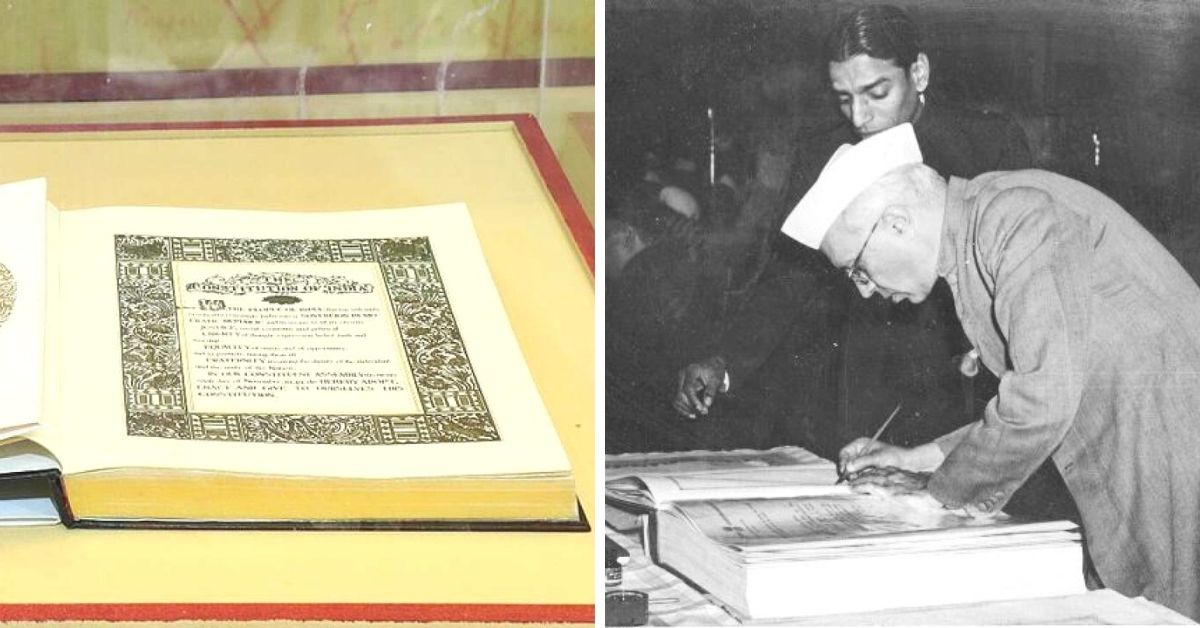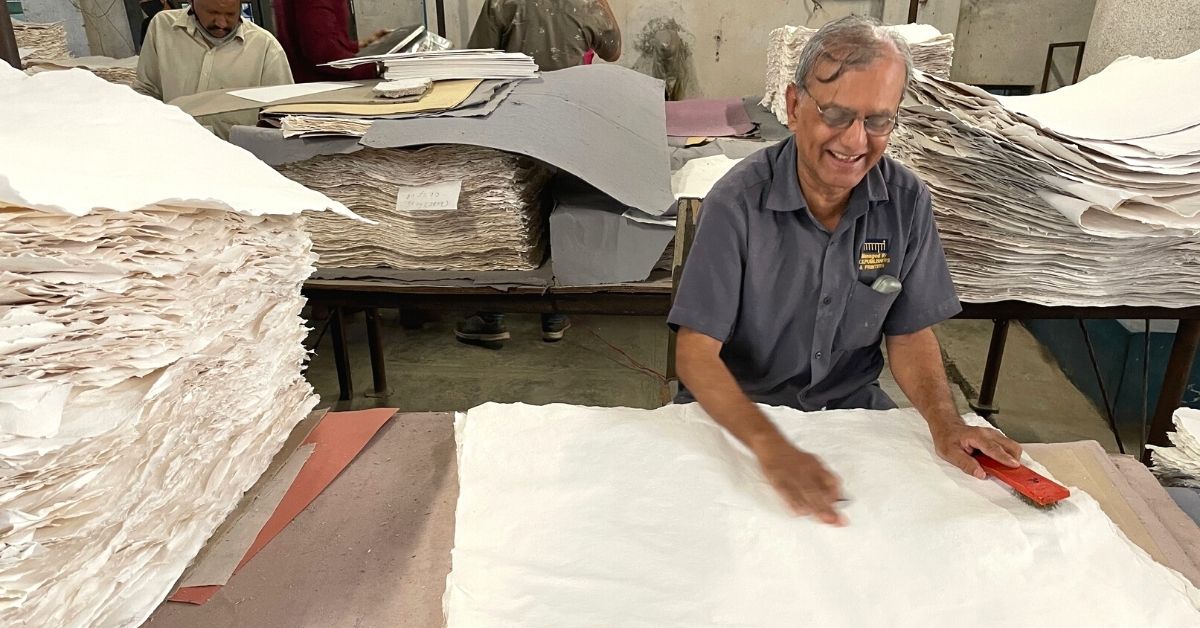Unsung Pune Factory Behind the Handmade Paper on Which India’s Constitution Was Written
Set up in 1940, the Pune Handmade Paper Institute (HMPI) has pioneered to create eco-friendly handmade paper using cotton rags that last up to 100 years

Despite living in Pune for 10 years I didn’t know that a small factory located in the heart of the city at Shivajinagar called Handmade Paper Institute (HMPI) has been making paper without using wood for years. The sustainable handmade paper is made using eco-friendly practices and is the first handmade paper making factory established during the pre-independence era.
Moreover, this tiny factory has contributed to making the handmade paper on which the Constitution of India was written and served all government departments, including the British.
“The factory was established complimenting the ideology of Mahatma Gandhi to introduce the ‘swadeshi’ movement in India. The factory is located on KB Joshi road, named after a Pune-based scientist, who was working on making handmade paper in India in the 1930s,” says Shobhana Hadap, director of the Studiomars Pvt Ltd, which manages the government-owned factory.
Shobhana says, in 1936, Joshi shared some samples with Mahatma Gandhi, upon which he was sent to Wardha Paper Centre to make handmade paper. “The aim was to employ the local population, but Joshi was not satisfied with working there. Eventually, the factory came to be set up on the premises of Agriculture College, Pune, and was inaugurated on 1 August 1940, according to the documentary Bharat Ki Ek Virasat,” she says.

The handmade paper factory was the first to be set up in India, after which others followed in other parts of the country.
Since its inception, the factory has never used any wood and has prepared paper from waste cotton using sustainable methods.
The making of
Explaining the process of hand papermaking, Kartik Joshi, marketing manager, says, “The paper is derived from 100 per cent cotton rags, a waste product from the textile industry and discarded unused cotton from the Pharma industries,” he says.
The cotton rags come from multiple sources and factories. They are collected and sorted, cut into approximate uniform sizes and cleaned. Once cleaned, the cotton rags get shredded into small pieces.
“These pieces are then mixed with water and blended in a beater. We follow a proportion of 20 per cent cotton and 80 per cent water in the machine. The beater has blades which chop and further reduce the size of the cotton pieces to blend them with water to turn them into a pulp. The entire procedure continues for almost 18 hours,” Kartik says.
The pulp is then poured into a storage tank and can be removed to prepare the paper as required. “To prepare paper, the pulp is poured on a netted wooden frame and spread evenly. The pulp is then cold-pressed to drain water and allowed to set. Later, it is compressed in a hydraulic press on woollen pelts, where the remaining water drains. The moist handmade paper sheet is sun-dried,” Kartik says.
Kartik adds that, however, the dried paper sheet formed has creases. “To even it out and form a straight uniform shape, the dried paper sheet is pressed on a roller machine. The paper is almost ready here. But at times, these sheets catch insects, stains or some particles which need removal. Hence, another manual process is carried out to remove and clean the sheets. The sheets now can be cut into any size as desired,” he says.
The factory follows the same procedure using recycled paper and cardboard.

“The handmade paper has incredible strength as it retains the tensile properties of cotton fibre. It is durable, chlorine-free, does not blot and can be used for printing. Moreover, this paper has a shelf-life of over 100 years. The handmade paper may turn yellowish depending on the weather conditions, but it will not get damaged,” he notes.
Kartik says the factory also specialises in preparing herbarium paper. “These papers have a pH value of around 4 and are required in botanical and medical labs for research. All the testing samples to be preserved require superior quality paper. We are the only ones manufacturing it in India. The entire process of paper making continues to be handmade, but the process such as shredding, beating and rolling have been mechanised with the development of technology,” he adds.
Shobhana says, “Dr BR Ambedkar used the same herbarium paper to handwrite the words on stationery made at this factory while declaring India as the Sovereign Democratic Republic in 1950 and writing the constitution of India.”
The art illustrations about the country’s history since the Indus Valley civilisation era found on the pages of the Constitution were drawn by artists such as Kripal Singh Shekhawat, Nandalal Bose and Rammanohar Sinha on the same handmade paper.
The Constitution now sits preserved in a helium case at the Parliament library.
Besides, Indira Gandhi commissioned an order to HMPI to print handmade paper invitation cards for her son Rajiv and daughter-in-law Sonia Gandhi’s reception, which took place on 26 February 1968, in New Delhi.
The former chief minister of Maharashtra, Yashwantrao Chavan, preferred sourcing handmade paper for letterheads from the institute.
Kartik says, “We continue to serve the government but have extended our sales to corporate companies and added exports to businesses abroad.”
A heritage to preserve

Today, the company also sells lamps, lanterns, painting paper, sheets, notepads, envelopes and other items, all made from handmade paper.
Mangesh Lohapatre, another director at Studio mars, says, “The factory was operated by the government initially, but for the past 30 years, it has started issuing managing rights to private companies for its operations. The factory has a rich history, but only a few are aware of it. We have started the shop to bring visibility and organise workshops on handmade papermaking, art events and other cultural festivals to increase the footfall.”
The factory faces challenges from the commercial establishment, who offer papers almost at 1/3rd the price compared to the handmade ones. “Their paper making methods are often unsustainable and harmful to the environment. Moreover, the factory generates livelihood for 50 by using a maximum workforce and minimal use of technology, making the process expensive. We need more customers to support our cause by buying handmade paper,” he says.
The company is working to come out of losses and hopes to reach a break-even point for its operations. “Profit is not our motive. But we need more government support for the same to continue its legacy and keep the Indian heritage alive,” Mangesh concludes.
For inquiries about buying handmade paper or booking a handmade paper making workshop contact Kartik Joshi at +91 7888003171 or send an email to [email protected].
Edited by Yoshita Rao
If you found our stories insightful, informative, or even just enjoyable, we invite you to consider making a voluntary payment to support the work we do at The Better India. Your contribution helps us continue producing quality content that educates, inspires, and drives positive change.
Choose one of the payment options below for your contribution-
By paying for the stories you value, you directly contribute to sustaining our efforts focused on making a difference in the world. Together, let’s ensure that impactful stories continue to be told and shared, enriching lives and communities alike.
Thank you for your support. Here are some frequently asked questions you might find helpful to know why you are contributing?


This story made me
-
97
-
121
-
89
-
167











